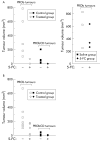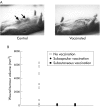Subcutaneous or intrahepatic injection of suicide gene modified tumour cells induces a systemic antitumour response in a metastatic model of colon carcinoma in rats
- PMID: 11839720
- PMCID: PMC1773127
- DOI: 10.1136/gut.50.3.387
Subcutaneous or intrahepatic injection of suicide gene modified tumour cells induces a systemic antitumour response in a metastatic model of colon carcinoma in rats
Abstract
Background: Suicide gene therapy consists of the transfer into tumour cells of a "suicide" gene that can convert a non-toxic compound into a lethal drug. Expression of the cytosine deaminase gene leads to the conversion of the non-toxic compound 5-fluorocytosine to 5-fluorouracil. We have recently shown that "suicide cell based vaccination" consisting of intrahepatic injection of cytosine deaminase expressing colon cancer cells followed by 5-fluorocytosine treatment induces regression of a distant wild-type liver tumour in rats.
Aims: This study was conducted to test if (i) a distant bystander effect on a liver tumour can be induced after subcutaneous suicide cell based vaccination and (ii) suicide cell based vaccination is efficient in limiting tumour dissemination to extrahepatic compartments.
Methods: An aggressive variant of rat colon carcinoma cells was selected after successive passages in vitro. Rats carrying an experimental liver "metastasis" generated by injection of these cells were vaccinated by subcapsular or subcutaneous injection of cytosine deaminase expressing cells followed by 5-fluorocytosine treatment.
Results: Subcutaneous and subcapsular vaccination induced 70% regression in the median volume of the pre-established liver tumour (p=0.001) and abolished tumour dissemination compared with control animals.
Conclusions: This study has compared for the first time the efficiency of subcutaneous and intrahepatic suicide cell based vaccination in a metastatic colorectal carcinoma model in rats. The results indicate that both modes of vaccination are equally efficient in inducing a systemic antitumour response, suggesting that this strategy is a powerful approach against the development and dissemination of metastatic colon carcinoma.
Figures



References
-
- Freeman SM, Abboud CN, Whartenby KA, et al. The “bystander effect”: tumor regression when a fraction of the tumor mass is genetically modified. Cancer Res 1993;53:5274–83. - PubMed
-
- Huber BE, Austin EA, Richards CA, et al. Metabolism of 5-fluorocytosine to 5-fluorouracil in human colorectal tumor cells transduced with the cytosine deaminase gene: significant antitumor effects when only a small percentage of tumor cells express cytosine deaminase. Proc Natl Acad Sci USA 1994;91:8302–6. - PMC - PubMed
-
- Dilber MS, Abedi MR, Bjorkstrand B, et al. Suicide gene therapy for plasma cell tumors. Blood 1996;88:2192–200. - PubMed
-
- Wilson KM, Stambrook PJ, Bi WL, et al. HSV-tk gene therapy in head and neck squamous cell carcinoma. Enhancement by the local and distant bystander effect. Arch Otolaryngol Head Neck Surg 1996;122:746–9. - PubMed
-
- Bi W, Kim YG, Feliciano ES, et al. An HSVtk-mediated local and distant antitumor bystander effect in tumors of head and neck origin in athymic mice. Cancer Gene Ther 1997;4:246–52. - PubMed
Publication types
MeSH terms
Substances
LinkOut - more resources
Full Text Sources
Other Literature Sources
Medical
